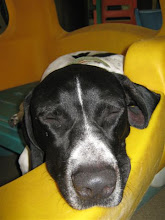Autumn can provide a beautiful backdrop for hiking: changing foliage, cool, fresh air, and exercise for you and your four-legged friend. You can increase the enjoyment by teaching your dog leash manners.
Many dogs pull on leash. The outdoor environment is highly stimulating. It's easy for your dog to "forget" his human at the other end of the leash. So many scents, so little time.... Dogs do what works for them. If you allow yourself to "go along for the ride" when your dog is pulling on the leash, you are reinforcing his poor leash manners. Remember that reinforcement makes any behavior stronger. Here are several changes you can make to eliminate your dog's pulling...and spare yourself possible injury!
ASSESS YOUR EQUIPMENT
Use a six-foot nylon or leather leash. A retractable, e.g. Flexi, leash is great for practicing distance stay and recall exercises, but not for teaching loose leash walking. It's easy for your dog to ignore you when she's 16 feet ahead! A six-foot leash allows easier control and reinforcement of your dog's position.
A walking harness may be helpful. A harness with the D-ring leash latch on the chest works best for strong pullers. (I like Premier's Easy Walk Harness.) It's discouraging for your dog to pull out in front when the leash is attached at his chest.
TAKE CHARGE OF THE WALK
Too much freedom is not good for a young or untrained dog. Keep the leash short: 12 inches for a large dog and 18-24 inches for a small dog. Do not give your dog the option of yanking you hither and yon. A short leash sends a clear message of your control.
REINFORCE ATTENTION AND LOOSE LEASH WALKING
Be prepared to reinforce nice walking with high-value food, e.g. your dog's favorite treats or a bite of chicken or hot dog. Remember that you are competing with the outdoor environment for your dog's attention! Have something compelling in your pocket. When your dog is walking nicely, give him a food reward. He'll learn that walking near you is worth his while. During your walk, interrupt him by saying his name. When he looks at you, give him a food reward. Your dog will learn to be attentive to you.
Your dog may pull even on a short leash. (After all, pulling has worked in the past.) No need to jerk the leash, simply, stand still. Stop walking and plant yourself. After a few moments, your dog will look at you and/or slacken the leash. Good dog! The walk continues. It's the continuation of movement that reinforces attention and a loose leash. Loose leash walking works instead of pulling.
Perhaps your dog has had many months to practice pulling on leash. Change doesn't happen overnight. With diligence, you can transform your walks into a more enjoyable experience!
Kimberly B. Mandel
CPDT-KA
908.822.9200
Model Desain Rumah Modern 2018
7 years ago



.jpg)


No comments:
Post a Comment